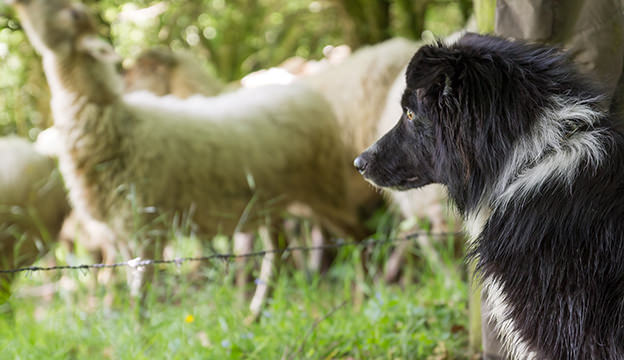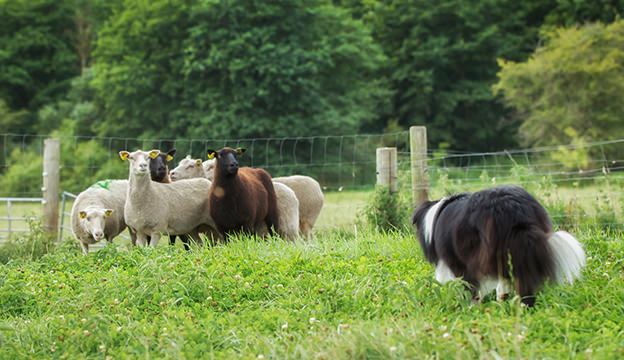
Training a young herding dog is an exciting and nerve-racking experience. It’s hard to believe that such a clumsy, comical little pup will ever become a useful partner in your livestock operation. But when you see that young dog transform into an intense, quivering bundle of concentration as it turns on to stock for the first time, I guarantee your heart will leap.
There is absolutely nothing like the power of a herding dog’s natural instinct to work. That’s why it’s heartbreaking when your pup doesn’t turn out the way you hoped. If you don’t start its training right, that dog could become a liability.
Keeping a Watchful Eye
First, keep your puppy away from dangerous or counterproductive situations. Avoid any contact between your young dog and livestock unless it’s under your supervision. It’s fine to get a pup used to being around your animals while you’re doing chores, as long as you can keep it safe and out of trouble.
It’s too easy for the dog to escape and get at the stock if you’re not attentive, and the result could be a disaster. Either the dog will get hurt and become fearful, or it will think it’s OK to harass or injure your stock.
Dog Training Age

Begin training your dog only when it’s mature enough to withstand the physical and cognitive rigors of training—usually 10 to 12 months old, though it depends on the individual dog. If you’re having problems early on, don’t get mad at the dog. You may need to wait a few weeks until it’s more mature.
Signaling Your Dog
Before you start training on stock, have a solid recall on your dog. If you can’t call it off when it’s chasing your sheep through a fence toward the highway or hanging by its teeth from a calf’s ear, you’re in trouble.
A young dog is so excited when it first starts working stock that it may not listen, but a stern command that it’s been well-trained to obey will eventually get through to its crazed brain. Some people also train their dog to lie down on command (essential to stopping or calming the dog and livestock) before training begins, but asking it to lie down on the kitchen floor versus out in the pen with sheep racing by yields wildly different results.
Training Time

When introducing your young dog to the farm, use calm livestock that are used to being worked by dogs. Four to 10 yearlings that are already “dog broke” are a good choice, because an older ewe or cow might challenge a young dog and make it fearful.
Many trainers use a round pen where the stock can’t get wedged in a corner, or they block off the corners in a square pen with panels. Some people work in an open pasture with a mature dog on hand to bring the sheep back before the pup chases them into the next county. Wherever you decide to start, try to set up an area where you can have some control over both the dog and the stock.
You may want to tie a long, thin rope to your dog’s collar so you can walk it up to your stock in a controlled manner and guide it around the stock if it shows any sign of wanting to head right into the middle of them. Once you see that the dog will circle your stock, you can let it go and be able to snag the rope and catch him later if he’s in trouble or about to collapse with exhaustion but doesn’t want to quit.
Don’t expect much from your dog in the beginning. Don’t say anything; don’t correct it. Use a calm, encouraging voice. Make it fun! You want to keep those early lessons stress-free and reinforce the pup’s desire to work.
Each dog matures and handles pressure at a different rate, so wait a few weeks to resume lessons if it shows fear or a lack of interest, is easily distracted, or chases the stock indiscriminately. (Note: If the young dog is eating sheep poop or taking a bathroom break, it probably means it’s nervous.)
A dog that is ready for training should have enough instinct to circle the stock and respond to your body language. If you step in front of the dog as it circles clockwise, it should change direction and circle in the opposite direction. Using the dog’s natural instinct to circle and react to the movement of both you and the stock is what all the early lessons are based on. It should be fun but productive. Dogs have a great way of signaling whether they’re serious or not—if their tails are up, they’re playing. If their tails are down, they’re thinking. Once you see that tail go down, you’ll know the pup recognizes that it has a purpose for interacting with your livestock.
The pressures of training quickly exhaust a young dog. End your session if the dog shows signs of stress, fatigue or inattention. That’s when it misbehaves and learns bad habits. Short, sweet lessons are the best for the dog’s early training. Above all, be patient. Work on a single skill at a time, and have it solid before progressing to the next. If the dog isn’t progressing the way you’d like, it’s usually the fault of the trainer—not the dog!
Advanced Dog Training
It takes time and commitment to train a good stock dog. If you plan to train the dog yourself, be aware that it’s easy to make major mistakes with a young dog. It could turn the dog off of herding forever. Do your research and educate yourself. If you are new to working with young dogs, get help from a respected trainer. You want to do the best for your dog. The joy of working in partnership with a good working stock dog and the invaluable assistance they will give you in managing livestock is well worth it.





One reply on “How To Train Young Herding Dogs”
[…] ~ Herding Foundation & Stock Manners As for training the dog yourself, I did find this link: How To Train Young Herding Dogs – Hobby Farms My uncle used dogs to herd his dairy cows. His method was to have the old dog train the new one. […]